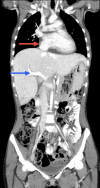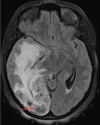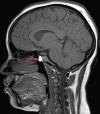When the Lightning Strikes Twice: Navigating the Complex Terrain of Cerebral Tuberculosis
- PMID: 38344590
- PMCID: PMC10858631
- DOI: 10.7759/cureus.52090
When the Lightning Strikes Twice: Navigating the Complex Terrain of Cerebral Tuberculosis
Abstract
Tuberculosis (TB), a Mycobacterium tuberculosis (Mtb) infection, remains a significant global health concern despite a declining incidence. This report highlights a complex case involving a 24-year-old patient from Angola who presented with a constellation of symptoms, including fever, weight loss, and neurological deficits. The patient had been on chronic corticosteroid therapy, a known risk factor for the reactivation of latent TB infection (LTBI). Her clinical course was marked by diagnostic challenges, such as a previous diagnosis of Kikuchi's disease and paradoxical progression despite appropriate tuberculostatic chemotherapy. Miliary TB, characterized by widespread dissemination of Mtb from the primary site of infection, can manifest in various extrapulmonary locations. Central nervous system (CNS) involvement, particularly TB meningitis, is the most severe form of TB, associated with significant morbidity and mortality. The diagnosis of miliary and CNS TB can be elusive due to nonspecific clinical presentations and imaging findings. This case underscores the importance of a high index of suspicion, especially in immunocompromised individuals, and the need for comprehensive microbiological analysis, including cerebrospinal fluid (CSF) examination, to confirm CNS involvement. Furthermore, this case illustrates the challenges associated with TB treatment, including the risk of drug toxicity, medication adherence, and the potential for drug resistance. Treatment duration for miliary TB is extended, typically lasting nine months to a year, and may require adaptation based on the patient's clinical response and drug penetration into the CNS. Corticosteroids play a critical role as adjuvant therapy, particularly in cases with perilesional edema or paradoxical reactions during treatment. This case underscores the complexity of diagnosing and managing miliary and CNS TB, emphasizing the importance of considering TB as a diagnostic possibility in patients with nonspecific symptoms and risk factors. Early identification, multidisciplinary collaboration, and tailored therapeutic strategies are essential for achieving optimal outcomes in such challenging cases. Additionally, screening for latent TB infection should be a priority for patients requiring immunosuppressive therapy to mitigate the risk of reactivation.
Keywords: antituberculosis therapy; central nervous system involvement; cerebral tuberculosis; corticosteroid therapy; disseminated tuberculosis; kikuchi's disease; latente tuberculosis reactivation.
Copyright © 2024, Sérvio et al.
Conflict of interest statement
The authors have declared that no competing interests exist.
Figures







Similar articles
-
Central Nervous System Tuberculosis in Immunocompromised Patients: A Case Report Emphasizing Immune Status and Early Recognition and Treatment.Cureus. 2024 Jan 22;16(1):e52715. doi: 10.7759/cureus.52715. eCollection 2024 Jan. Cureus. 2024. PMID: 38260110 Free PMC article.
-
Diagnosis and management of miliary tuberculosis: current state and future perspectives.Ther Clin Risk Manag. 2013;9:9-26. doi: 10.2147/TCRM.S29179. Epub 2013 Jan 8. Ther Clin Risk Manag. 2013. Retraction in: Ther Clin Risk Manag. 2015 Sep 28;11:1457. doi: 10.2147/TCRM.S96338. PMID: 23326198 Free PMC article. Retracted.
-
A Perplexing Case Highlighting the Diagnostic Conundrum of Miliary Tuberculosis Mimicking Sarcoidosis and Progressing Into Hemophagocytic Lymphohistiocytosis.Cureus. 2025 Feb 6;17(2):e78636. doi: 10.7759/cureus.78636. eCollection 2025 Feb. Cureus. 2025. PMID: 40062127 Free PMC article.
-
[Development of antituberculous drugs: current status and future prospects].Kekkaku. 2006 Dec;81(12):753-74. Kekkaku. 2006. PMID: 17240921 Review. Japanese.
-
Miliary tuberculosis: A new look at an old foe.J Clin Tuberc Other Mycobact Dis. 2016 Mar 18;3:13-27. doi: 10.1016/j.jctube.2016.03.003. eCollection 2016 May. J Clin Tuberc Other Mycobact Dis. 2016. PMID: 31723681 Free PMC article. Review.
References
-
- World Health Organization: Strategic and Technical Advisory Group for Tuberculosis (STAG-TB): report of the 22nd meeting. Geneva, Switzerland, 6-8 June: [ Jan; 2024 ]. 2023. World Health Organization: Strategic and technical advisory group for tuberculosis (STAG-TB): report of the 22nd meeting.
-
- Automated real-time nucleic acid amplification technology for rapid and simultaneous detection of tuberculosis and rifampicin resistance: Xpert MTB/RIF assay for the diagnosis of pulmonary and extrapulmonary TB in adults and children. WHO Guidelines Approved by the Guidelines Review Committee. https://pubmed.ncbi.nlm.nih.gov/25473701/#:~:text=Adults%20and%20Childre... Nat Lib Med.
-
- Fauci A. Harrison’s Principles of Internal Medicine. McGraw-Hill Professional Publishing; 2008.
-
- Extrapulmonary tuberculosis: an overview. Golden MP, Vikram HR. https://pubmed.ncbi.nlm.nih.gov/16300038/ Am Fam Physician. 2005;72:1761–1768. - PubMed
-
- Tuberculous meningitis: Challenges in diagnosis and management. Méchaï F, Bouchaud O. Rev Neurol (Paris) 2019;175:451–457. - PubMed
Publication types
LinkOut - more resources
Full Text Sources
